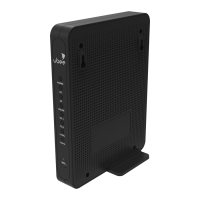Ubee Interactive Using the VPN Option
Ubee EVW32C Advanced Wireless Voice Gateway Subscriber User Manual • March 2017 74
Remote address
Identifies the specific remote IPsec VPN gateway to which your device will initiate the IPsec
VPN connection:
Use the IP address value when an IP address is the Network Address Type.
Use the FQDN if FQDN is selected.
IPsec settings
Pre-shared key
Defines your pre-shared key. A pre-shared key identifies a communicating party during a phase
1 IKE negotiation. It is called “pre-shared” because you have to share it with the other party
before you can communicate with them over a secure connection.
Phase 1 DH group
Defines which Diffie-Hellman key group (DHx) you want to use for encryption keys:
DH1 – a 768-bit random number (default setting)
DH2 – a 1024-bit random number
DH5 – a 1536-bit random number
Phase 1
encryption
Defines which key size and encryption algorithm to use for data communications:
DES – a 56-bit key with the DES encryption algorithm (default setting).
3DES – a 168-bit key with the DES encryption algorithm. The EVW32C and the remote
IPsec router must use the same algorithms and key, used to encrypt and decrypt the
messages or to generate and verify a message authentication code. Longer keys require
more processing power, resulting in increased latency and decreased throughput.
AES – the Advanced Encryption Standard method of data encryption also uses a secret
key. This implementation of AES applies a 128-bit key to 128-bit blocks of data. AES is
faster than 3DES. You can choose AES-128, AES-192, AES-256.
Phase 1
authentication
Defines which hash algorithm to use to authenticate packet data in the IKE SA.
MD5 (message digest 5) produces a 128-bit digest to authenticate packet data (default
setting).
SHA1 (secure hash algorithm) produces a 160-bit digest to authenticate packet data. SHA1
is generally considered stronger than MD5, but it is also slower.
Phase 1 SA
lifetime
Defines the length of time (from 120 to 86400 seconds) before an IKE SA process renegotiates
a key. A short SA lifetime increases security by forcing the two VPN gateways to update the
encryption and authentication keys. However, every time the VPN tunnel renegotiates the keys,
remote users are temporarily disconnected.
Phase 2
encryption
Defines the key size and encryption algorithm to use for data communications:
DES – A 56-bit key with the DES encryption algorithm (default setting).
3DES – A 168-bit key with the DES encryption algorithm device and the remote IPsec
router must use the same algorithms and key, which can be used to encrypt and decrypt
the message or to generate and verify a message authentication code. Longer keys require
more processing power, resulting in increased latency and decreased throughput.
AES – The advanced encryption standard method of data encryption also uses a secret
key. This implementation of AES applies a 128-bit key to 128-bit blocks of data. AES is
faster than 3DES. You can choose AES-128, AES-192, AES-256.
Phase 2
authentication
Defines the hash algorithm to use to authenticate packet data in the IKE SA. Choices are SHA1
and MD5 (default setting). SHA1 is generally considered stronger than MD5, but it is also
slower.
Phase 2 SA
lifetime
Defines the length of time (from 120 to 86400 seconds) before an IPsec SA process
renegotiates keys.
Advanced Settings
Label Description

